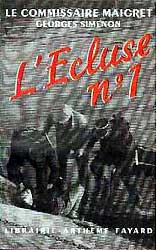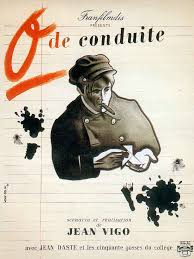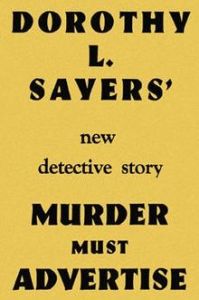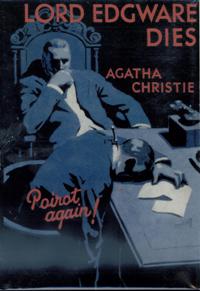Every month at Past Offences we review crime books and films from a chosen year. Jose Ignacio picked 1933 – peak Golden Age – for February.
 Bev started us off with Valentine Williams’ The Clock Ticks On, with a nice mirror-based cover.
Bev started us off with Valentine Williams’ The Clock Ticks On, with a nice mirror-based cover.
Valentine Williams had me mighty confused for the first few chapters–and it had nothing to do with the mystifying nature of the story. As mentioned above, his protagonist is a young Scotland Yard man. So, quite British, right? And, not only that, Dene would seem to be an educated policeman of sorts–having been to Cambridge and all. But as he’s traveling across the ocean towards the evidence in America, he and his fellow British passengers sound more like they’ve been raised alongside American gangsters than Cockney cabbies or British aristocrats.
 Back all the way across the Atlantic to France. Georges Simenon’s Lock Nº 1, featuring an almost-retired Maigret investigating the the attempted murder of a business man named Ducrau, appears at A Crime is Afoot.
Back all the way across the Atlantic to France. Georges Simenon’s Lock Nº 1, featuring an almost-retired Maigret investigating the the attempted murder of a business man named Ducrau, appears at A Crime is Afoot.
As usual, Simenon has been able to create the necessary atmosphere and tension in which the action unfolds, like no other writer has done before. And, while it’s certain that his plots are extremely simple, it is nonetheless true that any shortcoming in this sense is fully rewarded by the quality of his prose. Besides, as an observer of human behaviour, Simenon is almost unrivalled. I can’t overlook, that his stories are often rather bleak and sad, and the environments in which the action takes place are depressing. Maybe his books are not suitable for every taste and moods, but I have started to appreciate every day more this extraordinary book series.
Kerrie at Mysteries in Paradise also read Lock Nº 1, noting:
This is quite a heavy, dark feeling, novel. While Ducrau runs his businesses in a very hands-on way, and is well known, he is far from popular. His family and servants live in fear of him, and many people have reason to wish him harm. This is a fairly “typical” Maigret novel, with lots of psychological overtones.
 And now for another Simenon, John read The Engagement, about a downtrodden voyeur:
And now for another Simenon, John read The Engagement, about a downtrodden voyeur:
I was absolutely entranced by this tale. To be sure, M. Hire isn’t the most admirable of people — I don’t mean his physical repellence or his sad voyeurism, more his fleecing of other unfortunates through his unethical (but perfectly legal!) mail-order business — yet still I found myself rooting for him. By the time the combined efforts of the evil-minded concierge, the insouciant, mentally lazy cops and Alice and Emile have stirred up the locals to lynch-mob passions, M. Hire has become a near-Kafkaesque victim…
 Keeping it Gallic, it’s French movie time. Jean Vigo’s Zero for Conduct was reviewed at A Crime is Afoot.
Keeping it Gallic, it’s French movie time. Jean Vigo’s Zero for Conduct was reviewed at A Crime is Afoot.
One particular group of students plans to revolt against their tyrannical and eccentric schoolmasters during an alumni ceremony. When the event begins, the boys climb the roof of the school and rain tin cans and other garbage on the formal occasion and its participants… The premiere shocked many audience members who hissed and booed Vigo. Other audience members, most notably Jacques Prevert, loudly clapped.
Sounds a bit Iffy (geddit?)
 Back to the US. Kerrie’s next 1933 review was Erle Stanley Gardner’s The Case of the Velvet Claws, the first Perry Mason novel:
Back to the US. Kerrie’s next 1933 review was Erle Stanley Gardner’s The Case of the Velvet Claws, the first Perry Mason novel:
I can see why, even over 80 years on, why this novel was a winner with readers. The characters are well drawn, the action fast-paced and the plot is full of unexpected twists and turns. Perry Mason points out to his client. who constantly lies to him, that he is hardly a novice. He already has files from hundreds of previous cases in his filing cabinets, and he expects to have many more. He specialises in getting people out of holes. Most of the cases he has been involved in are murder cases, and mostly he gets people off.
 Bev then read The Clue of the Judas Tree, by Leslie Ford, with a millionaire shot dead in his own library.
Bev then read The Clue of the Judas Tree, by Leslie Ford, with a millionaire shot dead in his own library.
Everyone suspects that Michael Spur, a shell-shocked veteran of World War I, has had another episode. You see, Michael has killed once before while in a fugue state–the last victim was his father. But Lt. Kelley isn’t so sure. Did Michael kill while suffering a relapse? Or did he have a motive and hopes that the shell-shock excuse will keep him from the electric chair? Or…maybe someone else wanted Trent dead and has arranged for Michael to take the rap.
 Dorothy L. Sayers is the big hitter for 1933, of course. However, Bernadette at Reactions to Reading wasn’t impressed by Murder Must Advertise:
Dorothy L. Sayers is the big hitter for 1933, of course. However, Bernadette at Reactions to Reading wasn’t impressed by Murder Must Advertise:
I like a good yarn at least as much as the next person so am not averse to books in which plot takes centre stage but that isn’t really what happens here. The plot can be summed up pretty succinctly: a chap dies falling down stairs at an advertising agency, everyone thinks it’s an accident but for his….I honestly can’t remember now…sister I think but could have been the girlfriend…who somehow manages to engage the services of an English Lord and amateur sleuth to investigate. Much exposition and a fair amount of pompousness ensues.
Lucy at The Art of Words relishes the depiction of office life in Murder Must Advertise:
Adverts of the time were very wordy, with punning headlines, and Oxford graduates with a silly sense of humour were the best people to write them.
“Why not call it ‘Domestic Blend’? Nothing could sound more reliable and obviously nothing could suggest so much dreary economy.”
Sayers has fun with the awful products the staff have to push: tinned porridge, useless nerve cures, non-alcoholic beverages.
I’m with Lucy on this one. And Sayers’ own advertising work, The Mustard Club, remains one of the most viewed posts on Past Offences.
 Brad, whose ahsweetmystery blog has a spiffing new image at the top, read Agatha Christie’s Lord Edgware Dies, in which Poirot is asked to secure a divorce for beautiful actress Jane Wilkinson:
Brad, whose ahsweetmystery blog has a spiffing new image at the top, read Agatha Christie’s Lord Edgware Dies, in which Poirot is asked to secure a divorce for beautiful actress Jane Wilkinson:
Jane is a beautiful, fatuous creature (rather like Jane Helier in The Tuesday Club Murders), vain and amoral, but full of charm and, Hastings insists, true talent. Poirot wants nothing to do with her but reluctantly agrees to talk to Lord Edgware on her behalf. To everyone’s surprise, the unpleasant nobleman professes that he is perfectly willing to divorce his wife. Problem solved, case closed. And yet, one morning soon after, Lord Edgware’s dead body is discovered in his study.
Tracy at Bitter Tea and Mystery also read Lord Edgware, in its US guise of 13 at Dinner:
I noted that there were many female characters and a good number of them were supporting themselves. I don’t know how commonplace this was but I liked seeing that in a vintage mystery. None of them seemed to be the clinging type, although Jane, who is a successful actress, is looking for a marriage that will improve her status. Carlotta Adams, another important character, is an American entertainer who does impersonations. Carlotta is not doing so well financially, which is a key point in the book, but she is supporting herself. Also featured are Miss Carroll, Lord Edgware’s secretary, and Carlotta’s friend Jenny Driver, who has her own hat shop.
The Puzzle Doctor picked up on some different 1933 aspects in his review of Lord Edgware:
First off, what does this book tell us about 1933? Well, we’ve got that good old casual racism, as Poirot fears that a Jewish character will be in danger due to her love of money – at this point, Poirot knows nothing about her apart from her race. We’ve got the fact that Dame Agatha seems to think that “anyrate” is a word – she uses the phrase “at anyrate” at least four times in the book. We learn that in June 1933, “the hat of the moment was shaped like an inverted soup plate and was worn attached (as if by suction) over one ear, leaving the other side of the face and the hair open to inspection.” And being a “kinky sort of person” definitely doesn’t mean the same thing. See, who said you can’t learn things from blogs.
 JJ at The Invisible Event was underwhelmed by Philip Macdonald’s X v. Rex (written as by Martin Porlock), which is I’d always understood to be one I should read some day:
JJ at The Invisible Event was underwhelmed by Philip Macdonald’s X v. Rex (written as by Martin Porlock), which is I’d always understood to be one I should read some day:
This is decidedly more of a thriller than a crime novel – no small cast of suspects, no scattered clues, no sudden moment of retrospective reanalysis, no clever misdirection – you just sit and wait for the suspect to be apprehended three pages from the end and then that’s over and done with. There is one piece of sort-of misdirection, but it’s revealed fairly quickly and by that point I wasn’t really all that bothered. It certainly wasn’t clever enough to warrant a closer reading. Honestly, where’s the appeal?
The Puzzle Doctor agreed in his review of X v. Rex:
I didn’t find this to be the classic that people say that it is. Yes, it’s an original style and I’d really like to read one of MacDonald’s more traditional mystery tales. This feels like an experiment – maybe that’s why it was originally published under a pseudonym, Martin Porlock – but for me, it’s an experiment that contains some great parts but parts that do not combine to make a cohesive whole.
The Doctor was slightly more impressed with Robin Forsyth’s The Pleasure Cruise Mystery, even though it sounds like Ofsted was hovering over his shoulder.
As is often the case with a crime where only the sleuth suspects murder, the first half of the book is very talky. It was similar in Missing Or Murdered, but Vereker (who can be verbose at times) was talking to the more sensible Inspector Heather, which balanced things out. In fact, the “who solves the crime first” aspect of that tale was a real highlight. Here, he’s talking to Ricardo who a) doesn’t really care about the murder, his primary goal seems to be to seduce any woman possible, and b) is even worse than Vereker at using twenty words when one would have done.
 Another book probably not clever enough to merit a closer reading, although I’ve certainly read it a few times, is Margery Allingham’s Sweet Danger, which
Another book probably not clever enough to merit a closer reading, although I’ve certainly read it a few times, is Margery Allingham’s Sweet Danger, which
…seems rather timeless, and deliberately so. The wattle-and-daub fifteenth-century mill at Pontisbright with an ancient electric brougham parked in front, the local doctor practising an ancient brand of witchcraft in his front parlour, the Rupert-of-Hentzau storyline with a baddie who is a captain of industry rather than a captain in the Carpathian guards.
 New player Ho-Ling has been dipping into Ellery Queen’s Drury Lane (retired Shakespearean actor turned detective) novels, and read two from 1933 for us. He found The Tragedy of Z weaker than The Tragedies of X and Y (the first two in the series), slow to build and sagging a bit in the middle.
New player Ho-Ling has been dipping into Ellery Queen’s Drury Lane (retired Shakespearean actor turned detective) novels, and read two from 1933 for us. He found The Tragedy of Z weaker than The Tragedies of X and Y (the first two in the series), slow to build and sagging a bit in the middle.
That said though, the final part of the book, when Drury Lane reveals who the murderer is, is fantastic. This is what I expect from Queen! Slowly building a prison around his suspect with bricks of logic! Identifying the characteristics of the murderer, and comparing them to the suspects! The ending is really impressive, set in a memorable place with Drury Lane quickly, but convincingly proving who the murderer is.
Meanwhile, Drury Lane’s Last Case…
…is fairly different from the three previous Drury Lane novels though. For one, for most of the book, the plot revolves around the mysterious book-swapping in the museum. In short, this book is mostly a bibliomystery and murder only becomes a part of the play at the very end of the story. This is quite different from the three Tragedies, which basically all started with a mysterious death. For Queen fans, the bibliophilical angle shouldn’t come as a surprise: it’s a background the Queen cousins used very often in their books. And as there’s a Shakespeare link, it’s obvious why Drury Lane appears in this novel.
 Another new player, the scary-sounding-but-I’m-sure-very-nice Haruspex made their first foray into mystery reviewing with a look at Freeman Wills Crofts’ The Hog’s Back Mystery.
Another new player, the scary-sounding-but-I’m-sure-very-nice Haruspex made their first foray into mystery reviewing with a look at Freeman Wills Crofts’ The Hog’s Back Mystery.
The puzzle was certainly puzzling, and its disentangling scrupulous, to the point almost of absurdity. The tale’s strange lack of urgency, its willingness to take weekends off to go to Romney Marsh by train (express [p. 153]) and bus, to fuss with cigarettes and meals (“Breakfast was becoming quite a problem” as French searched the Earles’ house (p. 173), give it a narcotic detachment. I assume these small details are meant to give an illusion of humanness to the otherwise mostly wooden figures populating the book. There are occasional eruptions of humanity: the odd relationship between the snubbing Julia and her enamored young neighbor, for instance, though irrelevant to the mystery, is unusually startling and lifelike. Ursula Stone, from whose point of view we see the first few chapters, is another exception, but her interiority disappears long before her character.
Bev ended the month by reading Ethel Lina White’s Some Must Watch (later renamed The Spiral Staircase).
It was a dark and stormy night…. no, really, it was. Fortunately, Ethel Lina White was a much better author than the potboiler creators who are generally credited with starting their books in such fashion.
 Col’s Criminal Library read a 1933 novella by Nathaneal West. Miss Lonelyhearts…
Col’s Criminal Library read a 1933 novella by Nathaneal West. Miss Lonelyhearts…
…is a male agony columnist dealing with, or rather failing to deal with the problems brought to him by his readers. His cynical boss derides him and his ineffectual responses. Lonelyhearts seeks solace in drink and sex, involving himself more intimately in the problems of his readership as well as trying to seduce his boss’s wife. A temporary recourse to religion fails to provide a solution to anyone’s ills. A bar fight, an unhappy engagement, sex with a cripple’s wife and a grappling encounter with the cripple concludes with a gun going off. We end.
 Over to Clothes in Books for John Dickson Carr’s The Mad Hatter Mystery:
Over to Clothes in Books for John Dickson Carr’s The Mad Hatter Mystery:
I knew I had read this one before, a long time ago, and wasn’t sure what would come back to me. The answer is – one thing only, which is the explanation of what an opera hat is, and how it differs from a normal top hat. I could clearly remember the force of this revelation, even though it didn’t help me solve the murder.
And also an opera hat features in the very arresting cover in the US first edition.
I was sorry not to find a 1933 cover for John’s review of Marjorie Bowen’s Album Leaf,
It’s a breathless tale, and it’s told in a breathless, gushing prose. Bowen clearly found a supplier of cheap commas, because she uses them liberally in place of the more expensive full stops. It’s not just figuratively but literally a bodice-ripper — Lavinia’s bodice is actually ripped, and more than once, and she enjoys it, the shameless hussy.
Thanks as always to everyone who played, especially to newbies Ho-Ling and Haruspex. Usual apologies to anyone I’ve missed but I am a catastrophic administrator – feel free to link in the comments.
As Bev chose a book by Valentine Williams, and was therefore closest to the month’s theme of romance, she should get to chose next month’s year. However, Santosh already won that dubious honour by getting Solv-a-Crime correct. So next month it’s 1947. Bev, you can choose for April.



Just to point out that I also did Hags Nook this month (and X v Rex was yonks ago…)
By the way, congrats Rich as to how this meme has taken off. Looking forward to next month/year
LikeLike
Spiffy stuff!
I couldn’t find a cover of any sort for the Bowen. It’s odd that she’s drtopped into such oblivion, isn’t it? At one time she was a major bestseller.
The vt of Album Leaf is the far more evocative The Spider in the Cup.
LikeLiked by 1 person
The book is available at Project Gutenberg Australia. There is a cover there with her autographed picture. http://gutenberg.net.au/ebooks14/1401141h.html
There is a cover for the alternative title here https://s-media-cache-ak0.pinimg.com/236x/f9/60/c0/f960c0ba9aeae5074181d81a4cb6ee2a.jpg
LikeLike
Thanks, Santosh!
The “cover pic” at PGA is of course just PGA’s, so I wasn’t counting it, but the other one really is a bit splendid.
LikeLike
It is indeed, thanks Santosh
LikeLike
I’ve amended my Goodreads notes to include a link to it.
LikeLike
There is another cover at http://www.fantasticfiction.co.uk/s/joseph-shearing/album-leaf.htm
LikeLike
Not a patch on the other one you found, though!
What’s mysterious about these discoveries of yours is that they exist. When I went to write up my notes on the book at Goodreads, the site had never heard of it: I had to create the book’s entry there. While one accepts that there are some books that are so obscure that it’s easy for them to have slipped under Goodreads’s net, you wouldn’t have thought this would be one of them — as you’ve been proving.
LikeLike
slipped under Goodreads’s net
I meant “radar”, obviously. Or “through”. It’s late here.
LikeLike
Pingback: VINTAGE NOIR: Three Films from 1947 | ahsweetmysteryblog
What a great year! I *love* Murder Must Advertise – Sayers captures so brilliantly office life. Really I should re-read all her books…
LikeLiked by 2 people
I so wanted to be Mr Copley, rewriting a headline to a deadline, and share an office with all those gossipy typists and witty graduates! Dreams can come true, and this one did.
LikeLiked by 1 person
I love MMA as well. The office word play is so much fun!
LikeLiked by 1 person
Could Drury Lane’s Last Case have been filmed as Quiet Please, Murder – with George Sanders as a veeeeeeery creepy villain?
LikeLike
Interesting post. Coincidently the first Sayers I read was “Murder must advertise” and it made me start reading all her books, in chronological order. She became one of my most favourite detective writers.
Your post also reminded me to revisit Allingham 😊
LikeLiked by 1 person
A good number of authors here that I have not heard of, so very interesting in that regard. Thanks for continuing this meme, Rich, I love it.
LikeLike
Excellent work as always, really appreciate the effort that goes into this.
LikeLike
Another great line-up–thanks for gathering us all together! I’ll be back momentarily with a year choice (I have to remind myself which ones we’ve covered….).
LikeLike
Rich, I’d like to request 1945, please.
LikeLiked by 1 person
What a good year 1933 was: some really interesting choices. and so many people taking part…
LikeLiked by 1 person